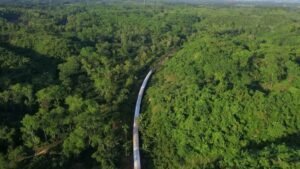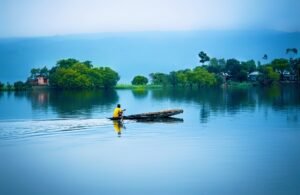By Train from Dhaka to Sylhet : An Unforgettable Thrilling...
Read MoreDiscover the Hidden Ocean of Bangladesh: Hakaluki Haor Will Leave You in Awe!
Hakaluki Haor the biggest haor of Bangladesh and the big recourse of Freshwater fish
Discover the Hidden Ocean of Bangladesh: Hakaluki Haor Will Leave You in Awe!
Sometimes the waves are as attractive and exciting as the oceans, but it’s not an ocean. Sometimes the waves are as calm and tranquil as the rivers, but it’s not the rivers. Can you guess what it is?
Yes, you are right—it is Hakaluki Haor, the largest wetland in Bangladesh. It invites you to experience a world where the melodies of countless birds, water, and air lull you to sleep as if you are in the lap of nature. Hakaluki is not just a wetland but a vast sanctuary for migratory birds.
The birds have plenty of fish to eat. This haor, also famous for its local and delicious fish, is home to many extinct species of fish. “Haor” is a Bengali word meaning underground or lower land. Here, water is the reality of daily life for the people.
Natural Beauty
During the rainy season, it’s like an ocean. Occasionally, you can see various aquatic plants, including Hijal and Tamal, standing on the water’s surface.
In the dry season, nature, foreign birds, and green land decorate it like heaven. Nature changes its appearance and looks like a green desert. An unknown path to the infinite horizon is created, making it even more attractive. If you see Hakaluki in the winter morning, it will seem as though Hakaluki surrenders to the winter with its massive body.
At that time, paddy fields and buffalo herds spread across the wide haor’s chest. The bills then float on the haor’s surface. About 112 species of fish are found in Hakaluki’s bill.
Activity
This largest reservoir in the world can fulfill the “sixteenth art of travel” for adventurous people. You can witness the floating life of fishermen on boats gliding across the haor.
Haor fish can be bought and eaten directly on these boats. If requested, the sailors can cook hot rice on the deck of the boat. Many visitors come here to enjoy the fresh fish of the haor while floating on its serene waters.
Hakaluki Haor is especially crowded with tourists during holidays. Many gather before dusk to watch the tired sun sink into the waters of the haor. The spectacular sight of the twilight sun setting over the vast haor waters will transport anyone to another world.
Bathan
Bathan is a Bangla word popular in the Hakaluki area. People living in the coastal haor regions, after the harvest, send their domesticated livestock to a group of caretakers in the haor. These caretakers look after the animals for a few months during the dry season of the year.
In exchange for their care, the caretakers receive milk. At the end of the period, the original owners return to reclaim their cows and calves. This entire system is referred to as “Bathan” in the haor area.
The herd owners earn a significant income by selling the milk from these cattle. Traditionally, the Hakaluki region has been renowned for its milk and curd.
Location
Hakaluki Haor is one of the largest freshwater wetlands in the country. It is surrounded by the Patharia and Madhav hills in the east and the Bhatera hills in the west. The haor stretches across five upazilas in the Moulvibazar and Sylhet districts.
Forty percent of Hakaluki Haor falls under Baralekha, 30 percent under Kulaura, 15 percent under Fenchuganj, 10 percent under Golapganj, and 5 percent under Beanibazar upazila.
The haor spans an area of 20,400 hectares or 181.15 square kilometers. It comprises 240 “bills”—a Bengali word that refers to the deepest parts of the lower land. This remarkable ecosystem is not only the largest haor in Bangladesh but also one of the largest freshwater wetlands in Asia.
Naming
The word “Haor” is believed to have originated from the word “Sagor,” which means “sea.” However, there are various folk tales about the origin of the name “Hakaluki.”
Many years ago, fearing the army of Maharaja Omar Manikya of Tripura, Hangor Singh, the leader of Baralekha, hid in a vast area of forest and mud. In Bengali, the word for “hid” is luki. Over time, the name of the area evolved from “Hangor Luki” to “Hakaluki.”
Importance of Hakaluki in Bangladesh
Hakaluki Haor is a protected wetland in Bangladesh and is considered one of the country’s most important fisheries. A variety of plants grow in the permanent water bodies of Hakaluki Haor.
Generally, two types of trees grow: rooted and floating. Hakaluki Haor is home to 526 species of plants and 417 species of birds, including 112 species of migratory birds and 305 species of native birds. In addition, there are 141 species of other wildlife and 107 species of fish, 32 of which are endangered to varying degrees.
The haor also supports 150 species of freshwater fish, 120 species of aquatic plants, and about 20 extinct species of reptiles. Every winter, approximately 200 rare species of guest birds gather here.
Hakaluki Haor is an extraordinary base for sustainable development and biodiversity conservation.
How to Go
First, you need to travel from Dhaka to Kulaura Station in Moulvibazar District. From Kulaura, Hakaluki Haor is very close. You can take a bus from Sylhet, such as Ena or Green Line, to reach Kulaura Station. Alternatively, you can travel by train or air.
If you choose to fly, you need to land at Sylhet Osmani Airport via a domestic flight, such as US-Bangla or Biman Bangladesh Airlines.
Where to Stay
You have three options for staying here. First, if you are an adventure lover, you can borrow a local tent to enjoy nature and interact with the local people. In the haor, 2-4 people can easily stay overnight in the huts of the bill tenants with the permission of the bill owner. The experience of camping in the beel area on a cold night will make the trip memorable.
Second option is Islampur village. Islampur is a prosperous village in the middle of the haor. It will take about two hours to get here from Fenchuganj. You can visit the village and ask a local house to cook for you. They will do so. If you want to stay the night, you can stay at their house.
Third, you can stay in the Dak Bungalow of Fenchuganj Zilla Parishad. Alternatively, you can go to Sylhet and find good accommodation in the upazila.
Don’t Miss the Food
The Haor area is widely known for its fish and its beautiful taste. It is also famous for milk and yogurt. The flavor of the local duck and chicken is also exceptional. So, try:
- Fish of Haor
- Milk and Yogurt
- Duck and Chicken
How to Manage Food While Boat Riding in the Haor?
During the haor trip, if you talk to the boatman and buy the necessary groceries, the boatman will cook and feed you.
Additionally, you can travel with light food such as biscuits, tea, bread, drinking water, etc., while boarding the boat. If you can arrange it with the locals in the haor, you can have lunch with them, including rice and fish broth, for a small fee. Cow and buffalo milk is available at a very low price in the haor.
Nearby Tourist Attractions
- Madhabkund Natural Waterfall
- Gagantila Rainforests
- Tea and Rubber Gardens
- Lawachhara and Satchari National Park
- Rema-Kalenga Wildlife Sanctuary
- Khasia and Manipuri Culture and Lifestyle
Conclusions
Hakaluki is more than a wetland; it’s like a bigger family of bells, rivers and canals.
it is a harmonious blend of nature’s magnificence, cultural heritage, and biodiversity. From the melodious calls of migratory birds to the captivating waves that shift with the seasons, Hakaluki offers a sanctuary for both wildlife and the human spirit. The haor is the life and living for its residents.
Here people live their life by Fishing, livestock, farming, boating and so on. Hakaluki Haor stands as a remarkable treasure of Bangladesh, waiting to be discovered.
A Tranquil Journey through Nature | Tanguar Haor Travel Guide
Tanguar Haor: A Tranquil Boat Journey through Nature Explore Tanguar...
Read MoreHakaluki Haor the Hidden Ocean of Bangladesh Will Leave You in Awe!
Discover the Hidden Ocean of Bangladesh: Hakaluki Haor Will Leave...
Read More

